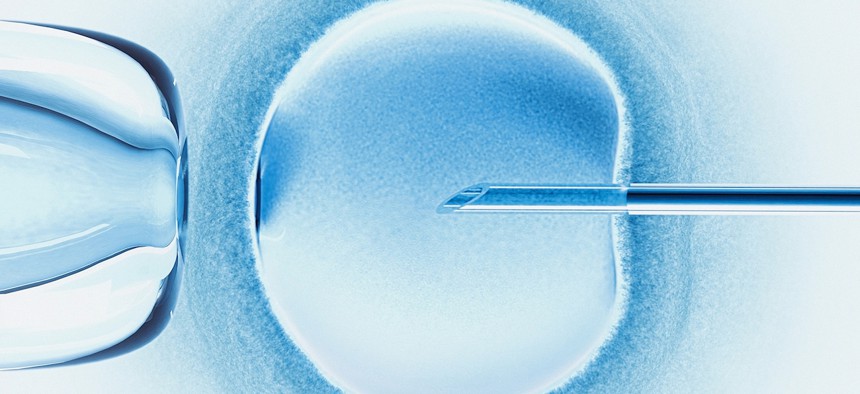
The cost of one IVF cycle can range from $15,000 to $30,000. Science Photo Library - KTSDESIGN/Getty Images
Feds Can Expect to See Improved Fertility Coverage from FEHB Plans in 2024
Compared to existing fertility benefits, this is a significant expansion.
OPM released their annual carrier call letter earlier this month, outlining the goals and initiatives federal employees can see from FEHB plans in 2024. One of the biggest changes is fertility coverage. From the OPM call letter:
- Carriers are required to provide coverage of artificial insemination (intrauterine insemination - IUI, intracervical insemination - ICI, and intravaginal insemination - IVI).
- Carriers are required to cover drugs associated with artificial insemination procedures.
- Carriers are required to cover the cost of In Vitro Fertilization (IVF)-related drugs for three cycles annually.
The impact: These 2024 changes represent an expansion of fertility benefits compared to what was available this year.
All FEHB plans currently cover the diagnosis and treatment of infertility, but most don’t cover assisted reproductive technologies (ART) and often have a long list of other fertility services that aren’t covered.
There are exceptions, however. Where available, most existing FEHB fertility coverage comes from HMO plans in states that have state-mandated fertility coverage. Currently, there are 20 states that mandate some form of fertility coverage, including Arkansas, California, Colorado, Connecticut, Delaware, Hawaii, Illinois, Louisiana, Maine, Maryland, Massachusetts, Montana, New Hampshire, New Jersey, New York, Ohio, Rhode Island, Texas, Utah, and Virginia.
HMO plans in those states usually cover one or two artificial insemination procedures, and sometimes cover fertility drugs, but rarely cover IVF.
The full picture: Any fertility benefit expansion is welcome news and a step in the right direction. But keep in mind a large portion of expenses will still be paid entirely out-of-pocket. The cost of one IVF cycle can range from $15,000 to $30,000, with fertility drugs accounting for only 35% of the total cost.
Additionally, several ART procedures don’t have required coverage, including In Vitro Fertilization (IVF), Embryo Transfer and Gamete Intrafallopian Transfer (GIFT), and Zygote Intrafallopian Transfer (ZIFT). Also missing are the cost of donor sperm, donor egg, donor embryo, or cryopreservation.
What to watch for: Families looking for fertility coverage in 2024 will need to consider their total healthcare costs and each FEHB plan’s benefit structure to find what meets their needs. Depending on the plan, you’ll see different cost sharing arrangements—fixed co-pays compared to coinsurance, and whether fertility benefits are provided before or after the deductible. There might also be benefit maximums or number of attempts that differ from plan to plan.
OPM is also encouraging plans to offer fertility benefits above and beyond what is required, including discounted rates for ART procedures that aren’t covered. Last year, OPM made the same recommendation and a handful of plans did comply, including the Foreign Service Benefit Plan, Indiana University Health Plan, and UPMC Standard and HDHP.
Some ways to save: Even with this benefit expansion, families will still face thousands of dollars of out-of-pocket expenses for fertility procedures. There are two ways to save:
- Flexible spending accounts (FSA) – Only about 20% of active federal employees have an FSA. This year, families can contribute up to $3,050 to an FSA, which is funded with pre-tax dollars through payroll deductions and amounts to about 30% savings on healthcare expenses paid with the account. FSAfeds manages the program, and if you don’t have an FSA, you can sign up during FSA Open Season, which shares the same dates as the 2024 FEHB Open Season: Nov. 13 through Dec. 11.
- Health Savings Accounts (HSA) – High-Deductible Health Plans (HDHP) provide an HSA, which has a higher contribution maximum than an FSA. Between the family and the HDHP, the HSA contribution limit this year is $7,750. Voluntary contributions made to the HSA lower your taxable income in the same way as an FSA, and you’ll save about 30% on your healthcare expenses when you use your HSA.
HDHPs tend to have lower premiums than many other plan types, but you’ll pay the allowed charge from the plan for all healthcare expenses before you meet the annual deductible. To help offset out-of-pocket expenses before the deductible, HDHPs, through premium reimbursement, will fund your account with anywhere from $1,500 to $2,400 per year, depending on the plan.
The Final Word
Families needing fertility coverage will get some help from FEHB plans in 2024. Compared to existing fertility benefits, this is a significant expansion. However, even with FSAs and HSAs, families will still experience high levels of out-of-pocket expenses.
Pay close attention to fertility benefits offered by plans this fall. Expect to see differences in how you’ll pay and if there are benefit maximums or limits on number of attempts.
While fertility benefits can be the most expensive predictable out-of-pocket expense you’ll have next year, make sure to also consider how a plan will cover your other known healthcare expenses and protect you from what you can’t predict.
Kevin Moss is a senior editor with Consumers’ Checkbook. Checkbook’s Guide to Health Plans for Federal Employees is available to many federal employees for free; check here to see if your agency provides access. The Guide is also available for purchase and GovExec readers can save 20% by entering promo code GovExec at checkout.







